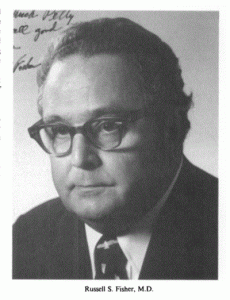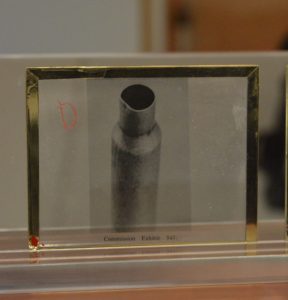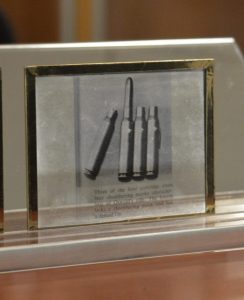OCME Holds Kennedy Slides as ‘Important Teaching Tools’
BALTIMORE — The earth-shattering events that surrounded the November 22, 1963 slaying of President John F. Kennedy will forever tie Dallas, Texas to one of the most agonizing moments in American history. But there is an important Baltimore connection to the assassination story – a connection to the careful forensic investigation which followed vexing questions about Kennedy’s late-night autopsy. We learned about this largely unknown link during a visit with our friend and colleague Bruce Goldfarb at Maryland’s Office of the Chief Medical Examiner (OCME).
Goldfarb – the Assistant to the Chief Medical Examiner – was in the process of setting up a display of JFK assassination-related glass slides.
“These are lantern slides, which are a precursor to the Kodachrome and Ektachrome slides you’re probably familiar with. They were used – and they’re still used actually – for teaching purposes. These particular slides belonged to Dr. Russell S. Fisher, who was the chief medical examiner from 1949 until around 1984. He used these slides to teach with – and to lecture on – the JFK case.”

Goldfarb said that in 1968, Fisher was one of four pathologists who were asked by then-Attorney General Ramsey Clark to evaluate the original autopsy report.
“And so that’s where these slides came from.”
As arguably the premier forensic pathologist in the United States at the time of the 1968 autopsy review, Fisher’s observations would have certainly been widely respected. A WWII Navy veteran who used his time in the service as a real-world laboratory, Fisher was personally recommended for his job here in Baltimore by no less a master forensic investigator than Frances Glessner Lee.
We wondered if Fisher had been involved in any way with the Bethesda Naval Hospital autopsy of President Kennedy?
“He wasn’t actually involved in what was going on with the autopsy at the Bethesda,” said Goldfarb. “That’s where Kennedy’s body was brought from Parkland Hospital in Dallas. But the guy who was at Parkland – (Dr. Malcolm) Perry – trained here in Baltimore. His picture is on the wall upstairs. So there’s that connection.”
The five glass slides on Goldfarb’s display (each about 3” x 5” in size) show a slightly dented bullet casing from a high-powered “Mannlicher-Carcano” rifle; a view of Elm Street and Dealey Plaza from the infamous Sixth Floor window of the Texas School Book Depository; two forensic renderings of the president’s wounds (the back/neck and head wounds); and a slide which shows a complete 6.5x52mm Carcano cartridge set between three spent shell casings of the same caliber.
One of the spent cases in the final group image is the dented casing from the first slide.
The Warren Commission established that Lee Harvey Oswald had purchased a Model 91/38 Carcano rifle with a scope. And while it is generally agreed that only three rounds were fired from this rifle on November 22, 1963, Goldfarb pointed out that a box of matching ammunition was found in the garage of the home where Oswald’s wife lived. Hence the un-fired round.

(Anthony C. Hayes)
“(Oswald) had a whole box of ammo, because that was one of the things I asked when I interviewed somebody at the FBI some years ago. I talked to the guy at the lab who actually did the neutron activation analysis test. The FBI wanted to make sure that all the slugs – all the pieces of metal that were recovered – all came from the same source. And this guy at the FBI told me, ‘Well, there you go, they did all come from the same box, and that therefore proves that one person did it.’
“I said, ‘Unless it’s proof of a conspiracy, because somebody could have distributed the bullets ahead of time for just such a purpose.’”
The various theories notwithstanding, Goldfarb said there is one key item missing from the Kennedy autopsy archives: the president’s brain.
“Kennedy’s brain is missing. Russell Fisher gave an interview with a local reporter (Blanie Taylor of the Journal) in the 1970’s and described what happened to Kennedy’s brain. Ultimately it vanished.”
Did it vanish before it left Dallas or from the Naval Hospital?
“My understanding was that it was delivered to the White House and was never seen again. So, supposedly, Bobby Kennedy made sure that it would never see the light of day.”
(Fisher’s conclusions from the 1968 autopsy review were published on pages 500-507 of Appendix Nine of the Warren Commission report. These conclusions – which were based solely on material available from the National Archives – generally supported the plausibility of the medical sumations in the Warren Commission Report. Fisher would later say that had the autopsy been performed in Dallas by Dr. Earl Rose – the coroner with legal jurisdiction of the slain president’s body – “The mistakes that were later made at Bethesda wouldn’t have been made.”)
* * * * *
With a new plexiglass stand to properly present the five images, Goldfarb told us the Kennedy slides would be joining a host of other artifacts in a large display case at the medical examiner’s office. But he was quick to stress that the slides and other items are not meant for public perusal.
“I understand people want to see these artifacts in person, but we just can’t accommodate everybody who wants to visit.

“We’ve got all sorts of other things in display cases; artifacts from accident and criminal cases that have been investigated here over the years. But this place is in a gray area, and we’re not generally open to the public. It’s listed in Atlas Obscura, but we don’t encourage visitors.
“You know, the good citizens of Maryland pay my salary to be the assistant to the chief and not a museum guide.
“Things at times – before the pandemic – were getting kind of out of hand with people dropping by to visit the lab. It hasn’t been a problem for the past year, but I don’t know. We may have to set up some viewing hours. Whatever you do, it is not going to be convenient for some people.”
Goldfarb said there are several other ways people could access the curious collection.
“We’ve done an awful lot to make these various artifacts accessible to the public.
“Corrine May Botz has the picture book of the Nutshell Cases called Unexplained Deaths. My book (18 Tiny Deaths) is a biography about the woman (Francis Glessner Lee) behind the Nutshell Cases. There’s a lot of material – plenty of pictures and video, and all kinds of stuff – online. And the nutshells are on exhibit for the Smithsonian. But again, you have to understand that these items were made for the purposes of teaching, and not for exhibition.
“They are important teaching tools.”

(Anthony C. Hayes)
© Copyright 2021 Baltimore Post-Examiner. All Rights Reserved

Anthony C. Hayes is an actor, author, raconteur, rapscallion and bon vivant. A one-time newsboy for the Evening Sun and professional presence at the Washington Herald, Tony’s poetry, photography, humor, and prose have also been featured in Smile, Hon, You’re in Baltimore!, Destination Maryland, Magic Octopus Magazine, Los Angeles Post-Examiner, Voice of Baltimore, SmartCEO, Alvarez Fiction, and Tales of Blood and Roses. If you notice that his work has been purloined, please let him know. As the Good Book says, “Thou shalt not steal.”
